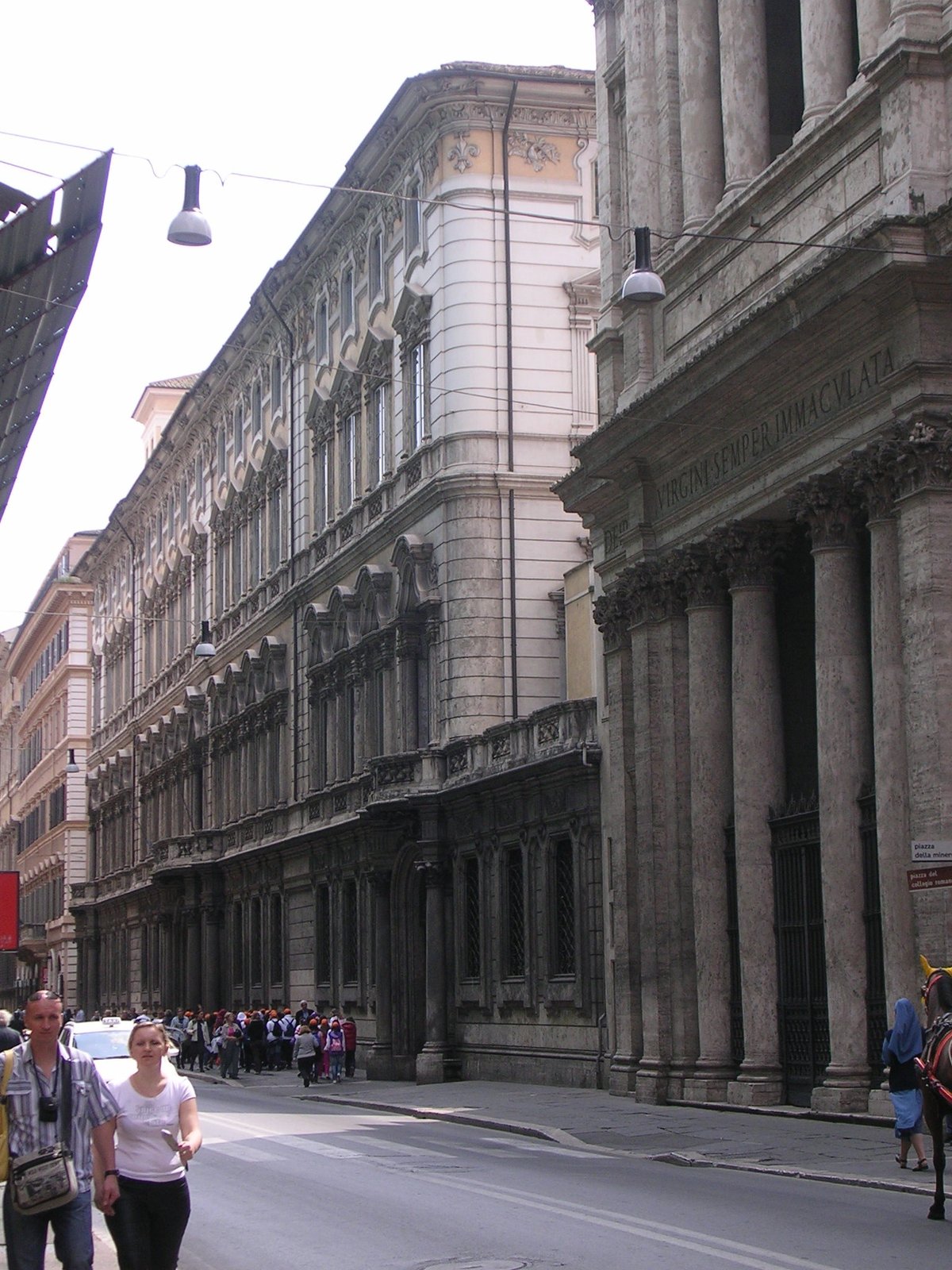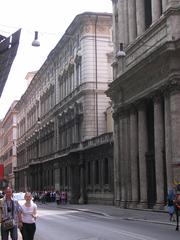
Santa Maria in Via Lata: Visiting Hours, Tickets, and In-Depth Guide to Rome’s Historic Church
Date: 14/06/2025
Introduction
Santa Maria in Via Lata is an extraordinary site that encapsulates the layers of Rome’s ancient, Christian, and Baroque history. Situated on the vibrant Via del Corso (ancient Via Lata), the church is renowned for its archaeological remains, spiritual traditions, and beautiful Baroque architecture. It is traditionally linked to the apostolic figures of Peter, Paul, and Luke, with the underground crypt believed to have housed St. Paul during his Roman captivity.
This comprehensive guide details the church’s history, significance, visiting hours, ticketing policies, accessibility, and practical tips to help you plan an enriching visit. Whether you are a pilgrim, a history enthusiast, or an admirer of art and architecture, Santa Maria in Via Lata offers a unique glimpse into Rome’s spiritual and cultural heritage. (Omnia Vatican Rome, Trek Zone, Florence Tickets, Crypta Via Lata)
Table of Contents
- Introduction
- Historical Overview
- Religious and Cultural Significance
- Notable Artworks and Architectural Highlights
- Archaeology and Preservation
- Visiting Santa Maria in Via Lata
- Frequently Asked Questions (FAQ)
- Conclusion
- References
Historical Overview
Roman Origins and Early Christian Foundations
Santa Maria in Via Lata stands on the site of a 1st–2nd century CE Roman warehouse (horreum), part of Emperor Hadrian’s urban redevelopment. The structure, running parallel to the Via Flaminia (now Via del Corso), reveals the commercial heart of ancient Rome. By the 5th century, the lower levels of this building were repurposed into an oratory and diakonia—a center for Christian charity—serving the city’s growing Christian community (Omnia Vatican Rome, Florence Tickets).
Archaeological and artistic evidence, including early Christian murals and inscriptions, attest to the transformation of this site from a pagan commercial hub to a sacred space.
Medieval Evolution and Diakonia
During the late 7th century under Pope Sergius I, the site’s diakonia was formalized, emphasizing charitable outreach and spiritual care (Florence Tickets). The medieval church, frequently rebuilt due to flooding from the Tiber River, was significantly raised above street level by Pope Leo IX in 1049. Remnants of the medieval apse and other structural elements remain visible today (His.com PDF).
Baroque Transformation
The church’s most striking transformation occurred in the 17th century under Pope Alexander VII, when Pietro da Cortona designed the Baroque façade and reconfigured the interior. The new design, completed in 1660, features Corinthian columns, a grand portico, and statues symbolizing Christian virtues (Florence Tickets). The upper church is adorned with rare marbles, significant funerary monuments, and the venerated icon of the Virgin Mary, “Mary Advocata,” central to the church’s Marian devotion (Omnia Vatican Rome).
Religious and Cultural Significance
Santa Maria in Via Lata holds a special place in Christian tradition. According to legend, its crypt was the residence of Apostles Peter, Paul, and Luke during their time in Rome. St. Paul is believed to have spent two years here under house arrest, preaching and writing letters that became part of the New Testament. Tradition also associates St. Luke with painting the earliest portrait of the Virgin Mary at this site (Omnia Vatican Rome, EWTN Vatican).
The church’s diakonia emphasizes its ongoing commitment to charity, while its role as a “station church” during Lent connects it to Rome’s oldest Christian liturgical traditions (Wikipedia).
Notable Artworks and Architectural Highlights
The Crypt: Apostolic Legacy and Early Christian Art
The crypt preserves elements of the Roman warehouse, including barrel-vaulted ceilings and masonry. Frescoes from the 7th–9th centuries depict biblical scenes and saints, offering a rare glimpse into the spirituality and artistic expression of early Roman Christians. Baroque bas-reliefs and inscriptions honor the apostolic tradition and reinforce the church’s sacred narrative (EWTN Vatican).
The Upper Church: Baroque Splendor and Marian Devotion
The upper church’s Baroque interior is characterized by a single nave, side chapels, and a richly decorated apse. The 12th-century “Mary Advocata” icon is the focal point, traditionally attributed to St. Luke. Surrounding artworks, including frescoes and altarpieces, narrate the lives of St. Paul, St. Sabina, and other saints. The main altar, triumphal in design, draws the eye upward, symbolizing the ascent from earthly to divine.
Artistic Treasures and Decorative Elements
Chapels feature altarpieces, sculptures, and polychrome marbles from notable Roman Baroque artists. The church is adorned with memorials to prominent families and religious figures, including monuments by Carlo Fancelli and Santi Ghetti.
Archaeology and Preservation
Recent excavations have uncovered wells, vases, and iron chains in the crypt, supporting traditions of apostolic imprisonment. Early Christian frescoes are preserved both on site and at the Crypta Balbi National Roman Museum. Ongoing conservation projects ensure the church’s layered heritage remains accessible for generations (Omnia Vatican Rome, Trek Zone).
Visiting Santa Maria in Via Lata
Visiting Hours
- Main Church:
Typically open Monday to Saturday: 9:00 AM–12:30 PM and 3:30 PM–6:00 PM.
Official site hours may differ, with some sources listing daily opening from 17:00 to 21:00 (or 18:00 to 21:00 in summer) for liturgical activities (Crypta Via Lata). - Underground Area (Crypt):
Fridays: 14:30–17:00
Saturdays: 9:00–17:00
Always verify current hours before visiting, as they may change for holidays or special events.
Ticketing and Admission
- Main Church: Free entry, donations encouraged.
- Underground Area: Ticketed access (€12.00 full price, €7.00 reduced). Group rates and free tickets may be available for certain visitors (Omnia Vatican Rome).
Accessibility
- Main Church: Some steps at the entrance; confirmed ramps or lifts are not always available.
- Crypt: Narrow stairways and uneven floors make it inaccessible for visitors with limited mobility or claustrophobia (ItalyXP).
- For more accessible churches, consider Santa Maria in Trastevere or St. Peter’s Basilica (Carrie Ann Lightley).
Guided Tours and Visitor Tips
- Guided tours are highly recommended for a comprehensive understanding of the site’s history and art (Florence Tickets).
- Early evening visits allow participation in liturgical services and a more tranquil atmosphere.
- Modest attire is required; bring a scarf or shawl to cover shoulders and knees.
Facilities and Services
- No dedicated visitor center or on-site café; numerous options available nearby on Via del Corso.
- Restroom facilities are not specified; plan accordingly.
- Photography is permitted (no flash during services).
- Regular liturgical services are held, including daily Mass, Eucharistic Adoration, and the Rosary.
Nearby Attractions
Santa Maria in Via Lata’s central location makes it easy to combine with other historic sites:
- Piazza Venezia
- The Pantheon
- Roman Forum
- Piazza Navona
Frequently Asked Questions (FAQ)
Q: What are the visiting hours for Santa Maria in Via Lata?
A: Main church: Monday–Saturday, 9:00 AM–12:30 PM and 3:30 PM–6:00 PM. Liturgical events: 17:00–21:00. Crypt: Friday 14:30–17:00, Saturday 9:00–17:00. Confirm on the official website.
Q: How much do tickets cost?
A: Main church: free. Underground area: €12.00 full price, €7.00 reduced (Omnia Vatican Rome).
Q: Is Santa Maria in Via Lata accessible for wheelchair users?
A: The main church has some steps and no confirmed ramps; the crypt is not accessible.
Q: Are guided tours available?
A: Yes, and they are recommended for exploring both the church and the crypt.
Q: Can I take photographs?
A: Yes, discreetly and without flash.
Conclusion
Santa Maria in Via Lata is a living monument to Rome’s enduring legacy, blending ancient Roman ruins, early Christian heritage, and Baroque artistry. Its crypt offers an intimate encounter with the city’s apostolic past, while the upper church dazzles with its art and architecture. Whether you’re seeking spiritual reflection, historical insight, or artistic inspiration, this church is a must-visit on any Rome itinerary.
Plan ahead by checking current visiting hours and ticket information. Guided tours will deepen your appreciation for the site’s stories and treasures. For the latest updates and more travel tips, download the Audiala app and follow us on social media.
Image Suggestions
- Exterior view of Santa Maria in Via Lata, Rome
Alt: “Baroque facade of Santa Maria in Via Lata church in Rome” - Interior with verde antico columns
Alt: “Interior of Santa Maria in Via Lata featuring verde antico marble columns” - Underground oratory area
Alt: “Ancient underground chambers of Santa Maria in Via Lata”
Interactive Elements
- Map showing the church’s location on Via del Corso.
- Links to virtual tours via official or trusted tourism platforms.
Internal Links
References
- Omnia Vatican Rome: Entrance Ticket Basilica of Santa Maria in Via Lata and Underground
- Trek Zone: Santa Maria in Via Lata, Rome
- Florence Tickets: Basilica of Santa Maria in Via Lata and the Underground Areas
- EWTN Vatican: First Dwelling of the Apostles in Rome
- Crypta Via Lata: Official Site
- Wikipedia: Santa Maria in Via Lata
- ItalyXP: Pantheon Underground Tour
- Carrie Ann Lightley: Rome Disabled Access Guide
- WhichMuseum: Visiting Hours
- Romapedia: St Mary on Via Lata
- Wanderlog: Santa Maria in Via Lata


















































































































































































































































